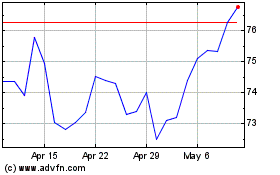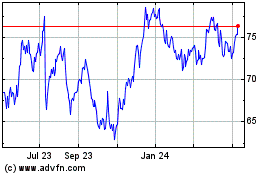State Street Is Cutting 1,500 Jobs -- Update
January 18 2019 - 5:18PM
Dow Jones News
By Justin Baer
State Street Corp. said Friday it would shed about 1,500
employees, a new sign that the asset-management industry's
struggles are rippling through the rest of Wall Street.
The cuts will sweep through higher-cost offices such as Boston,
New York and London as State Street automates parts of its
operations. They include the 100 or so senior management jobs the
bank had previously announced and represent less than 4% of the
company's roughly 40,000-person workforce.
The job reductions mark a more aggressive phase in the custody
bank's yearslong plan to trim expenses, root out manual processes
and keep pace with the dramatic changes under way at many
investment firms.
What explains the added urgency is a late 2018 market rout that
spooked investors and punished the asset management industry. State
Street provides the bookkeeping and other back-office services to
nearly 90% of the biggest investment firms.
"Market dynamics are changing for our clients," Ronald O'Hanley,
State Street's chief executive, said to analysts on Friday. "The
resulting margin compression for investment managers has led them
to increase pressure on their providers."
Asset managers are wrestling with the challenges posed by uneasy
investors and shaky markets as more firms compete to push prices
lower. Last year clients started to commit less new money to
investment funds and other products. Then a market selloff reduced
the value of assets managed by many of these firms, further
draining the fees they pocket for managing others' money.
BlackRock Inc., the world's biggest asset manager, said this
week that its assets fell by roughly $468 billion in the fourth
quarter. Last week it announced 500 job cuts as a way of coping
with the shifts under way in its industry.
State Street isn't the only service provider to the asset
management industry looking to pare back. Bank of New York Mellon
Corp. said Wednesday it had set aside severance expenses in the
fourth quarter as it began to eliminate layers of managers
throughout the company.
At State Street, the need to take out costs didn't seem quite so
urgent when Mr. O'Hanley spoke last month at an investor conference
and revealed the plans to cut about 15% of senior managers, or
roughly 100 people. That was before the market's selloff steepened
in the final weeks of the year, and investors were confronted with
new worries, including the effects of a prolonged partial shutdown
of the U.S. government, Mr. O'Hanley said.
"We certainly control our destiny," the CEO said in an
interview. "But in terms of the market levels, and the underlying
market sentiment in what investors do, we don't control that."
State Street also said Friday that in the fourth quarter its net
income rose 19% to $398 million, or $1.04 a share, from $334
million, or 89 cents, a year earlier. Excluding charges and other
items, State Street earned $1.68 a share in the most-recent period.
On that basis, analysts had expected a $1.70 profit.
Revenue rose 4.9% to $2.99 billion, slightly above analysts'
average estimate. The bank's shares closed 25 cents higher, at
$71.30.
State Street finished the year with $31.6 trillion in assets
under custody, down from $34 trillion at the end of the third
quarter. The firm had $2.51 trillion in assets under management, an
11% drop from September.
Write to Justin Baer at justin.baer@wsj.com
(END) Dow Jones Newswires
January 18, 2019 17:03 ET (22:03 GMT)
Copyright (c) 2019 Dow Jones & Company, Inc.
State Street (NYSE:STT)
Historical Stock Chart
From Mar 2024 to Apr 2024

State Street (NYSE:STT)
Historical Stock Chart
From Apr 2023 to Apr 2024
